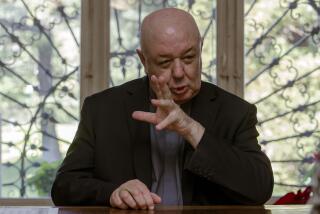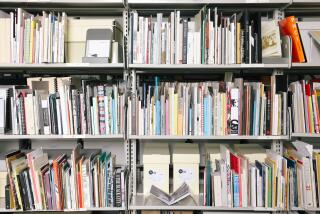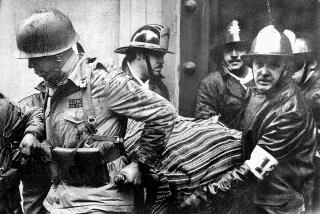Postscript : Communism’s Shrine of Secrets : The party’s archives in Moscow may be open, but security is daunting for prying scholars and reporters.
- Share via
MOSCOW — The cold, unfriendly air from Repository No. 5 raises goose bumps as it escapes into the hallway. The door, so heavy it would look at home on a bank vault, swings slowly open with haunted-house menace to reveal row upon row of gray metal file cabinets.
The dim room beyond the threshold is not quite the Holy of Holies of the once all-powerful Communist Party regime. But it is one of the most secret of its sanctums, a shrine where no foreigner was ever meant to set foot.
Stepping inside triggers a quick thrill and a surge of curiosity. Somewhere amid the floor-to-ceiling drawers of protocols, minutes, orders and correspondence--3 million documents in all--lay the solutions to puzzles that have baffled Sovietologists for decades, the records of the inner workings of the party empire. The only trick is in knowing where to look.
Since March, the archives of the Communist Party Central Committee have been officially open to any researcher with the time to delve into the policy-making of the past, from the early 1950s through 1981.
Scholars and reporters sifting through the files have been coming out with new revelations almost weekly--from confirmation that the Communist leadership supported Middle East terrorism to absurd minutiae about Central Committee involvement in chess societies and hang-gliding.
The rash of disclosures can be deceptive, however. The archives are officially open--but in many ways, they are still closed.
Security remains daunting, with two guards at the building’s door to check that would-be researchers have gone through the red tape to get permission to use the files--calling ahead and bringing an official written request. Most researchers are limited to the grandiose reading room, furnished in part with theater-style rows of seats beneath gilded pillars and giant, warm-toned portraits of Karl Marx and V. I. Lenin.
From there, they order materials from catalogue lists of documents, and more often than not are told that the files have yet to be declassified.
“You could say that we’re just a little bit open,” archive Deputy Director Vladimir Chernous said before a brief escorted tour which included the forbidden zones housing banks of index cards that record the bureaucratic path of each document--but not the treasure rooms where the files themselves are kept.
To penetrate even as far as Repository No. 5 and its card banks, an archivist-escort had pressed a sequence of code buttons to enter the hallway from the stairwell and used a large skeleton key to open the repository door.
Then she chose a smaller key from a closet hung with dozens of them, opened a waist-high drawer and, seemingly at random, pulled out a white index card.
“Sekretno”-- Secret--was printed along the top of it.
She shrugged. “It was secret back then,” she said.
Card 77515 held no great disclosures--only the index listing for a report of the Communist Party Central Committee’s International Sector on the decision to fly some Lebanese Communists to Moscow in 1986.
But from another drawer nearby, the archivist--who would identify herself only as Lena--pulled another card, also stamped Sekretno. It catalogued a 1980 document that appeared to have originated in the Soviet Foreign Ministry and passed through the hands of top KGB officers and, intriguingly, Mikhail S. Gorbachev, then a high party official.
The description of its contents was tantalizing: “It was considered worthwhile to take further measures concerning Sakharov”--the late Nobel Peace Prize-winner Andrei D. Sakharov, who was long persecuted by the KGB for his human rights activism.
Perhaps some enterprising scholar will report someday soon on just what those measures were. Lena did not offer to retrieve the file and find out.
These nuggets lie everywhere in the noble old building down Ilyinka Street from the Kremlin.
The newspaper Trud (Truth) recently carried an array of excerpts documenting the party’s persecution of author Alexander I. Solzhenitsyn, including his exile and the instructions sent to Soviet embassies around the world that the missions should convince their host countries that the author’s “Gulag Archipelago” was nothing but nasty anti-Soviet propaganda.
It has long been common knowledge, of course, that the KGB bugged and hounded dissidents, that foreign Communist parties were propped up by Soviet funds and that the party intervened directly in theater and literature.
But the archives provide solid new proof that what everybody thought they knew was indeed true. They fill in gaps in knowledge and give scholars the kind of documentation they need to write with authority.
“For us, historians, it’s just crucial that every fact be bolstered by documents,” said Ivan Ostapenko, an elderly man scrolling through microfilm on Soviet labor relations.
Ostapenko said he has found nothing really new so far, but he remains convinced that he will discover the truth about the real state of the Soviet working class--its labor conflicts, on-the-job accidents, employee turnover and working conditions.
Dr. Victor Topolyansky, sitting at another microfilm viewer in the hall’s front-most desk, said he was seeking not sensations but a deeper understanding of what had happened to leave his country’s medical system in such sad straits.
“I don’t understand how it happened that a country that could be among the best countries in the world ended up in the situation it’s in now,” he said, stretching and cracking his spine after hours hunched at the viewer. “What happened? How did it happen? When did it happen?”
These are the kind of serious scholars that archive Deputy Director Chernous likes--and they were the only breed to be found among the dozen denizens of the reading hall during a recent visit.
It is a more exotic ilk of researcher that Chernous worries about--the foreign journalists who use the documents to spice up politics at home.
Chernous recalled the chagrin he felt when a British newspaper publicized documents proving that Labor Party leader Neil Kinnock had met with officials of the Soviet Embassy in London, printing them just before recent elections.
“We don’t want our information to destabilize politics in other countries,” Chernous said. “The archives do not act as a political force. We don’t have political goals.”
Nonetheless, the archives contain powerful political ammunition. Russian President Boris N. Yeltsin’s lawyers have used them extensively in their attempts to prove the Communist Party unconstitutional at a trial in Moscow.
And Yeltsin’s men have even claimed that they have documents implicating Gorbachev--who remains Yeltsin’s rival despite his step back from the political arena--in Soviet funding for terrorism.
Such choice documents remain off-limits for the public, however, locked away in the most secret of archives--the documents of the party’s ruling Politburo and the Soviet presidency, which are stored within the Kremlin and only come to light when Yeltsin’s team deems it worthwhile to leak them.
The Kremlin archive, with its top-level secrets, is likely to remain closed, Chernous said. Researchers must content themselves with the Central Committee files and the older party archive on Pushkin Street, which stores materials through 1951 and is fully open to the public.
The Central Committee archive is considered the hottest new source of historical documents, but it has plenty of company. Libraries across the country are gradually releasing the books and papers from their “closed access” sections, providing wonderful new fodder for scholars.
Even the KGB archives are partly accessible now, available to children looking for information about the repression of their parents and other truth-seekers willing to write a letter requesting the documents they want to view and to wait a month or more for an answer.
That the Central Committee archives are so slow in producing exciting disclosures appears to stem less from political calculation than from technical problems.
Chernous said the archives are too short of funds to be able to afford computer time on their centralized system, which now belongs to the government, and almost all work is done by riffling through catalogues and files.
“Everything is done by hand here,” he said. “It’s very labor-intensive.”
More to Read
Sign up for Essential California
The most important California stories and recommendations in your inbox every morning.
You may occasionally receive promotional content from the Los Angeles Times.













